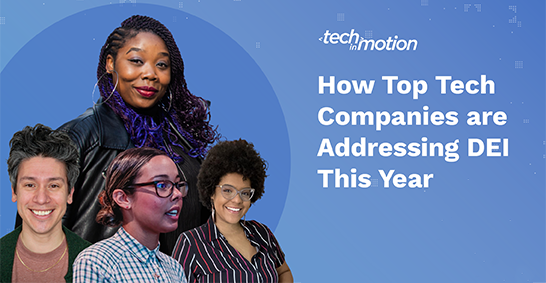
Tech companies across North America are continuing to see the importance of robust Diversity, Equity and Inclusion programs, with a recent survey showing that 89% of prospective employees believe DEI to be a crucial aspect of work culture. Tech in Motion invited thought leaders inside the tech world to have a discussion on the state of diversity in tech. Guests included our moderator Lindiwe Davis, Diversity, Equity & Inclusion Leader at Google and our panelists Lais Rodrigues, Diversity & Inclusion Analyst at Avenue Code, Ashley Jordan, VP of Operations & Strategy, Re:work Training and Colin Espinales, Program Manager - Diversity, Inclusion & Belonging at LinkedIn. Watch below to see the full event and continue reading below to see some of the highlights of the conversation.
What are some of the best practices for creating a culture of Equity and Inclusion?
When it comes to building an inclusive team/business/organization, a major key is having diversity in leadership. Ashley Jordan said, “No matter what processes or practices you have in place if you don’t have diversity and leadership in upper and middle management, employees are not going to show up entirely authentically, particularly the ones who feel like they’re not represented in leadership.”
Having diversity in upper management can also lead to establishing mentor programs inside the company, where managers and higher-level employees can meet with newer hires. “When you see someone who looks like you who’s gotten to that place (management positions), it tells you that you can do it and you can where you’re at,” said Colin Espinales.
Going beyond having diversity in management, knowing who your employees are and listening to them is vital to the success of and DEI initiative. Jordan told us, “The worst thing you can do is assume what people need and not ask them…It is antithetical to inclusion to rely on leadership’s perspective to create a prescriptive effort into what people actually need.”
Lindiwe Davis added later on in the conversation, “One of the biggest things is understanding how to hear the story that a person is trying to convey to you, because if you can hear the story, then you yourself as a leader can act upon that story.”
Tools, resources and tech for exploring and celebrating unique perspectives
To get a better grasp of who is in your company and how to create an inclusive environment, many of the leaders on our panel said that surveys were a great tool to learn how programs are going. “Surveys are a wonderful tool,” said Lais Rodrigues. “I need to understand the reality of my company. I need to understand who is on my team."
Espinales agreed, saying, “When I’m looking at programs and think about successes and how we’re growing them, I think surveys obviously are a really great way to get the feedback and figure out how to make those tweaks…what’s resonating with your communities.
Depending on your business, bringing in a 3rd party to help guide you on implementing these programs might be the best way forward, while working entirely internally has its benefits as well. Ashley Jordan noted that there are some people that will find a 3rd party a bit more trustworthy, while Davis mentioned that internal teams that might have access to management that will have the ability to “move the needle” and facilitate change inside the company.
Tech in Motion's Next Event: Women in Product & UX Design on March 10th. RSVP Now!
How to find and attract diverse tech talent
While having programs and initiatives inside a company is helpful to building a diverse and inclusive environment, equally important is creating hiring practices and systems that allow businesses to attract and source diverse talent. One of the first ways is to have a number of unique voices in the hiring process. As Rodrigues said, “You need to have people who know…who have lived in that world.”
Another point mentioned was for companies to expand what it means to be qualified. Companies need to look past the typical ways candidates acquire skills and fully realize what they’re looking for in these positions. Espinales said, “You can’t define what that skill is from what I’m used to knowing where that skill comes from.” Beyond that, companies should better understand what qualifications they are looking for in certain positions. Looking for a 4-year degree with 5 years of experience for an entry-level role isn’t feasible and restricts otherwise viable candidates from joining your company.
Final Takeaways
All of the panelists agreed that major factors for successful DEI programs are investments in both time and money. “You cannot expect your employees to volunteer to make your company a better place,” said Jordan. As DEI continues to evolve, companies that listen and expose themselves to different cultures will create a successful environment for all employees to succeed. “Working in the DEI space can be challenging and beautiful, but it is worthwhile. If you have a team, you have a budget, and you have grit, you can do so many amazing things in your company,” Davis said. “DEI in and of itself is needed, and it should be a priority.”
Tech in Motion's next event, Women in Product and UX Design, is being held on Thursday, March 10th at 1 pm EST/Noon Central. An all-star panel of female Product and & UX Design technologists share insights into how to find success as a woman in design. Free to attend, RSVP Today.
